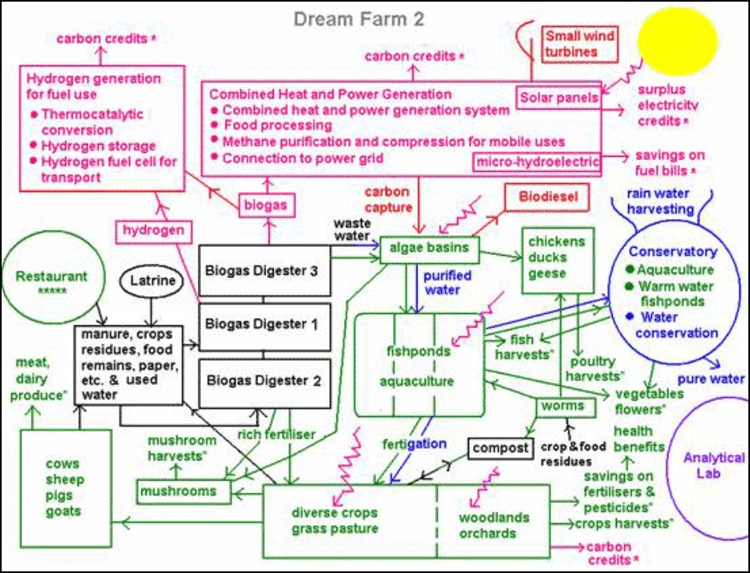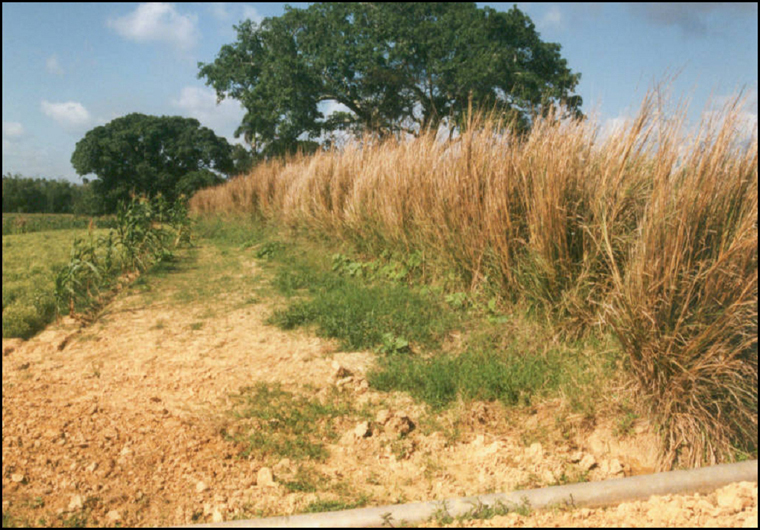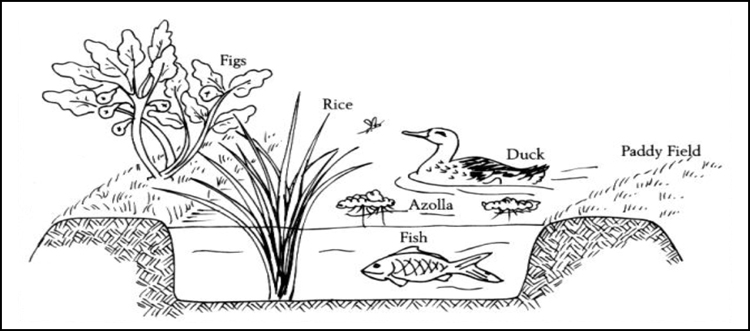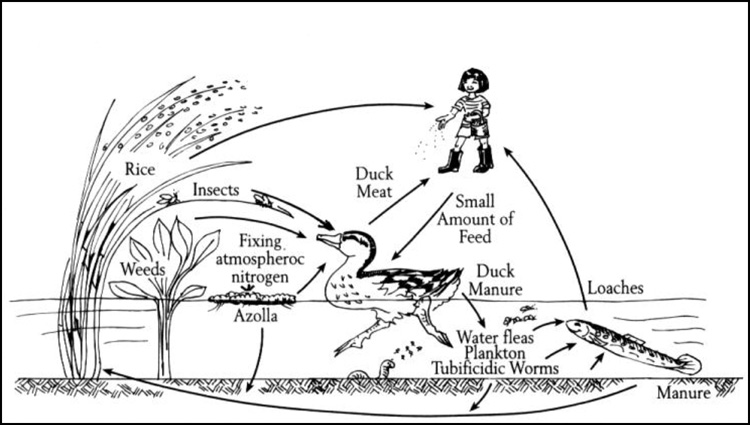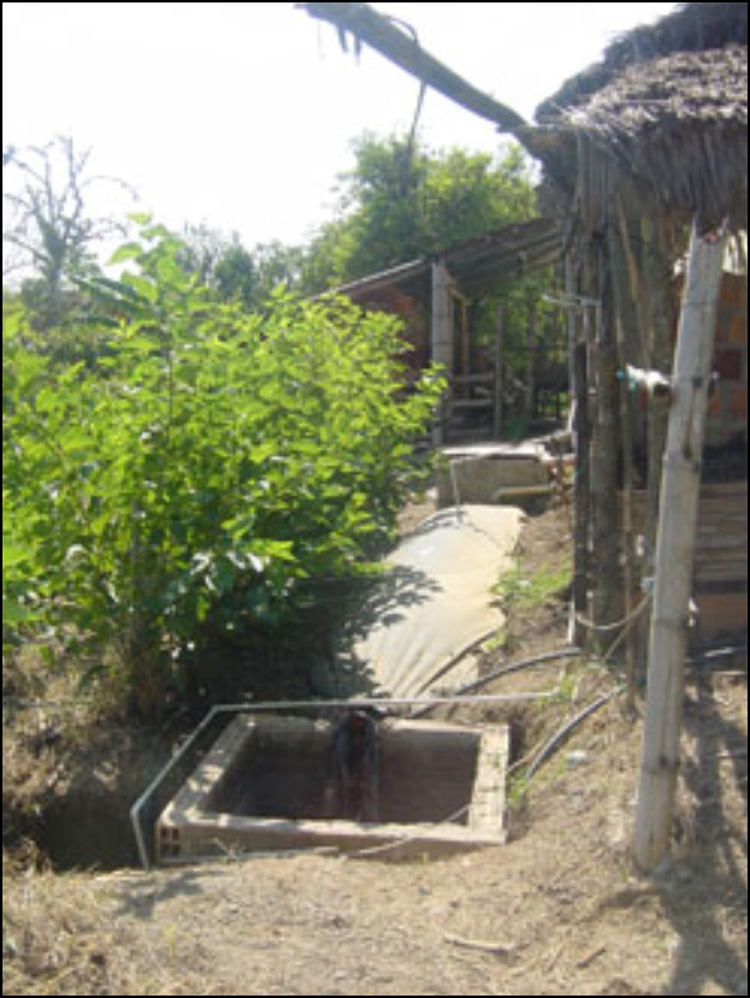development patterns: July 2010 Archives
by Karl North
This series of articles is an exploration of designs for agriculture in Tompkins County to approach sustainability in a future of declining access to the cheap energy and other inputs on which our industrialized food system relies. In earlier parts of this series, I proposed principles of agroecosystem design; addressed the key issues of fertility, energy, water, and pest control; and pictured the future county food system as a whole, including its historical context, implications, and the interdependencies among the parts that will make them most effective as an integrated system. I said that providing for the local food needs of urban populations requires a design that integrates three overlapping categories of production systems: urban agriculture systems (many small islands of gardening in the city center), peri-urban agriculture (larger production areas on the immediate periphery), and rural agriculture (feeder farms associated with village-size population clusters in the hinterland of the city but close enough to be satellite hamlets).
In this month’s article I will consider the needs and resources that will shape the design of future agrarian communities sharing a symbiotic relationship with the city of Ithaca and will offer a case study as a design example.
A general agricultural model
In rural parts of the county, space and other resources provide the opportunity to redesign agriculture most fully according to the general integrated system model described in Part Two of this series. Moreover, the many existing or reclaimable wetlands in the county offer the prospect of sustainable systems on the model exemplified in Part Two by the colonial farming system of Concord, Massachusetts. In colonial times, many agrarian communities in the Northeast made this grassland form of chinampa-style agriculture (Part Five) the core of their farming system. Communally managed wetlands were central because they sustainably produced the fertility that drove the system, indirectly via hay and thence manure, and directly from muck dredged from the canals:
These wetlands required considerable hydrological manipulation to make them productive, and they were transformed to a carefully managed resource in many towns. Extensive systems of drainage ditches, sometimes connecting for miles, rendered the meadows firm and accessible for teams during the mowing season, whereas dams, dikes, and road causeways provided hydrological control and augmented fertilization from natural flooding. Mowing, burning, and grazing, in combination with manipulation of the water table, shifted the composition of many wetlands from tree and shrub dominated to a cover of desirable grasses and sedges. The meadows returned a reliable yield of rather coarse hay, along with a rich muck that was cleaned from the ditches in the fall, dried, and carted to the barnyard or plow land.[1]
In land systems both wet and dry, grazing species such as the multi-functional cow formed the core of agriculture in colonial New England and sustainable agroecosystems in Cuba and elsewhere. They will likely be central to rural farming systems designed to survive the petroleum era.
A reconfigured social topography
Changes in rural land use, while not directly the subject of this essay, should be considered when envisioning a new plan for agriculture. If, like earlier societies that lacked fossil fuels, our society must use less energy to feed more people, it will require smaller, denser population centers with residences close to places of work. This constraint applies not only to cities such as Ithaca, but also to peripheral feeder towns and to the social topography of rural agriculture. In the US, cheap energy, cheap land, and the individualist ethic of “every man his castle” modeled on the European ideal of a landed aristocracy spawned a pattern of suburban sprawl on one hand and isolated farms on the other. In recent decades, the farms had to grow larger and even more isolated to survive in an agricultural economy where agribusiness multinationals exert monopoly control.
The traditional pattern in Europe is markedly different: apart from estates left over from feudalism, rural populations in Europe are even now clustered in agricultural towns and villages that include the farm residences and barns of many of the farmers who go out to work the surrounding land.
Energy descent planners in the US, including ecovillage advocates like Ithacan Robert Morache,[2] have made a strong case for converting to the European model of rural population centers, because, unlike suburban sprawl, this model clusters both farm and non-farm rural populations to make efficient use of energy, land, and transportation resources that link to nearby urban centers. Ideally, these farming villages, circled by their farmlands, will replace present configurations of land use, in particular suburbia and many of the remote farms operated on the industrial model, both of which are unlikely to survive the end of the oil era. Whether our society will have the material resources or the political will to make such a complete conversion is an open question at this point. See the TCLocal article Post-Peak Land Use Part 2: The Country for more detail on the farming village model.
Visioning a satellite farming village case: Lansing Landing
Imagine a once-thriving farming village connected to the county seat by good water, rail, and road transport routes that had in later times become a bedroom community. Now revived as a satellite ecovillage, buildings that serve a variety of agricultural, residential, and service functions are densely clustered in a hub surrounded by land devoted to diverse but related farming enterprises. Individual families and private cooperatives manage the enterprises within the general goals and guidelines set by the community and the county. Along with the community’s commercial agricultural output, many households are engaged in homesteading production from kitchen gardens and small-scale animal husbandry. The village is planned with a systems design, well illustrated in the permaculture movement, which uses both food and nonfood species for the greater health of the farming community and its ecosystem: it organizes them functionally, spatially, and temporally in a calendar with a decades-long time horizon to serve this goal.
Today’s ecovillages have made a start on the agro-integrated design that will be required here in the future. Figure 1, based on a study of the Ithaca Ecovillage, demonstrates some of the flows, interdependencies, and synergies that can be captured in a farming ecovillage designed as an integrated system.[3]

Figure 1. Ecovillage interdependencies (drawing courtesy of Jason Fleischer)
Lansing Landing builds on the example of many ecovillages today, but aims for a higher standard of sustainability, including the need for greater heat and energy self-sufficiency; affordability (many ecovillage dwellings are too expensive for the average person); diversity of functions, including farming as the core function; and more complete recycling (how many ecovillages collect and process night soil?). Some of the components and functions present in the community envisioned here attain the high level of integration planned for an agricultural community in the United Kingdom by the Institute for Science in Society, as illustrated in Figure 2.[4]
Figure 2. Functional integration in a planned agricultural community
Fertility. Open, sloping land plays an important role in the village agroecosystem. As described in Part Two, animals graze a hillside system[5] of perennial forages dotted with food-producing trees. Hedgerows crisscross this landscape, surrounding fields and carving them into enclosures of appropriate size. Hedgerows serve many functions: shelterbelts, perennial food species, and fences. They stop erosion, and by so doing even begin the process of reshaping hillsides into arable terraces. Figure 3 is an example of terrace formation from Cuba.
Figure 3. A hedgerow in Cuba stopping soil movement on a slope
The grazing animals participate in a fertility scheme where a surplus of manure is built up as bedding packs in barns where stock is overwintered, then processed in the main village vermicomposting center. This fertility scheme is the foundation of village wealth production, and so ultimately determines its quality of life. Farmers also use the grazing animals to optimize biomass production in row crop acreage whenever the acreage is in a grass rotation.
Along with biodigested humanure from the village and the city of Ithaca, applications of compost made from winter livestock manure and bedding create the tight nutrient cycling that builds and sustains the fertility of the land. Manure and village sewage that is more conveniently handled as liquid is fed through a fuel-producing biodigester, then solids separators followed by cleansing ponds that grow duckweed for high protein animal feed, and finally back to fields as in Figure 2. Village farmers use a sophisticated scheme of fallows, rotations, and winter- and roller-killed cover crops to further control fertility and weeds with minimal tillage.[6]
Water and wood. In Lansing Landing, ponds have been placed high on the hillsides to capture spring water and runoff for many uses: village and livestock supply, water power, and irrigation, to name a few. Lower ponds recapture water for additional uses: recreation, fire protection, and a village reserve. They function as part of a water management array of berms or swales, like the keyline plan described in Part Two, that keep water working within the watershed as long as possible.
Drawdown of forest resources to the point of crisis occurred repeatedly in European and U.S. history before the oil age, when biomass was the main source of energy. Forest cover in Tompkins County dropped from almost 100% in 1790 to 19% by 1900, then increased to 28% by 1938 and to over 50% in 1980.[7] Most of the loss of forest cover can be attributed to a combination of logging for firewood and timber and clearing for livestock production and other agriculture. The much bigger present county population will make far greater demands on forest resources. It would be mistaken, therefore, to assume on the basis of current forest cover that the county can rely on wood for its future energy needs.
The village actively manages enough forestland to do its part in providing county forest product needs, among which firewood for heat and timber for shelter are paramount. By replacing the extremes of no management and monoculture that were luxuries typical of an earlier era, active management stimulates both biodiversity and production in a balance to achieve a wide range of agroforestry goals. Many forests are maintained on ridge tops and uplands for the health of the watershed. Groves near the village center create useful microclimates, temper prevailing winds, and provide for recreation.
Food and Fiber. The imperative of energy efficiency has gradually reconfigured land use in this village to cluster the more intensive agricultural activities in the flat, most fertile land ringing the village center. This circle contains the rotating fields of starch staples, vegetable polycultures, meadows for the most intensive animal husbandry, and fibers like hemp and flax. Its output of foods and fibers that traditionally grow well in the region help ensure the food security of the county.
Crops like flax and hemp, which produce fiber, oil, and other ingredients of manufactured products such as paper, clothing, paints, and preservatives have reappeared as competing petroleum products have disappeared and competition for forest products has increased. Different parts of the hemp plant produce flour and oil for food, paper, and composites, including boards that reduce logging pressure on forests, rope and cloth, lubricants and other petrochemical substitutes, and important nontoxic medicines. Hemp productivity per acre is four times that of sustainably harvested wood, and twice that of cotton-without cotton’s need for pesticides.[8]
Not far from the village is a wetland modified with canals and ponds to grow aquaculture crops. Because of the constant source of crop water, the wetland system is an anchor that guarantees a reliable source of forage and bedding for livestock both in the village and in the peri-urban animal enterprises.
Part of the wetland has been developed into a true chinampa-style production system. As described in Part Two of this series, the chinampa configuration of aquaculture in canals surrounding raised fields is integrated in a way that ensures higher productivity over dry-land agriculture. While most examples of this system come from Central America and Southeast Asia, the system has also succeeded in northern Japan in a water-moderated climate similar to ours in Lansing Landing. Figures 4 and 5 from Japan demonstrate some of the possibilities.[9]
Figure 4. A rice-fish-duck-azolla system. Azolla (duckweed) is a floating fern that fixes nitrogen and produces protein
Figure 5. Material cycles of azolla + loaches + ducks + rice. The system produces rice, duck meat, duck eggs, and fish for a small input of feed
The core of village livestock husbandry is the dairy enterprise, much of which has returned to the energy-efficient model of seasonal, grass-fed milk production from the hillside pastures and hay fields. Breeds chosen to fit the system are hardy, dual-purpose, and smaller than the energy-intensive breeds of the industrial agriculture era that were designed to maximize production at any cost. Cows, sheep, and goats are pastured along with work mules and horses in a multi-species grazing system that benefits from the complementary grazing functions of the different species. Dairy and crop byproducts sustain some pig and chicken production. The level of animal production is determined by the role of animals in supplying ecological services to the community’s agriculture, not by county demand for animal food products, which is currently excessive and unhealthy. At Lansing Landing, the level of production of animal foods is closer to what is needed for a healthy human diet.
Like animal genetics, the genetics of the crops grown by the village have changed to reflect the exigencies of the post-petroleum era. Instead of hybrids that sacrifice local seed control and the resilience that a large gene pool provides, village farmers, employing traditional selection methods, have developed open-pollinated seeds that they can save and share. While yields from savable seeds can rival the productivity of hybrids[10], village farmers have selected for both plant and animal types that balance productivity with traits like hardiness and other low-maintenance characteristics.
Village Enterprises. Even closer to the center, to be within walking distance of their workers, are animal and crop barns, village-scale composting and biogas digester sites, tool manufacture and repair shops, and other agricultural support facilities. One example is a piggery used to turn compost. Fed largely from dairy byproducts and kitchen garbage, its manure in turn feeds a small biogas generator like the one in Figure 6.
Figure 6. Biodigester made with one layer of plastic tubing 1.2 m in diameter and 6 m long, connected to a pig pen with 20 animals and fenced with Mulberry tree. Finca Ecológica Tosoly, UTA Foundation, Guapotá, Santander, Colombia. Photo: Lylian Rodriguez
Processing plants that preserve raw farm products while reducing water content to make them more transportable are village enterprises that serve an important function in the county food system. Examples include the conversion of milk and fruit to aged cheese and preserves and the lumber-drying sheds at sawmills. Near the center of town is the village recreational fish and skating pond, one of the ways a stream running through the valley has been harnessed.
One of the important functions of the village is to recruit and train new farmers from the urban population to run the more labor-intensive agriculture of the new era. An educational complex serves as a public school for the village, an agricultural research and farmer training center, a farm camp for urban youth, and an adult farm camp for harvest volunteers and vacationers from Ithaca. In turn, the village draws on urban populations for short pulses in labor needs, like haying and other harvest activities that must be accomplished in a brief window of opportunity.
Rural agriculture and the county food supply
This series has described three types of area agriculture needed to sustain a county population of 100,000: urban, peri-urban, and rural. Of these, rural agricultural systems will be of primary importance. Urban and peri-urban gardens can provide quantities of fresh vegetables and fruits, but only rural farms have the space to grow enough of the starchy staples like potatoes, grains, beans, and rice that have historically supported urban population densities. Moreover, only rural farms can supply enough of the materials like oils, fibers, and wood that are basic necessities in our cold climate. Agrarian villages, not the urban center, will again become the heart of a relocalized county food system in the coming years.
Notes
[1] Redman, Charles L. and David R. Foster. Agrarian Landscapes in Transition: Comparison of Long-Term Ecological and Cultural Change. Oxford: Oxford University Press, 2008.
[2] Morache’s plan of village clusters in the urban hinterland includes farms, residences for urban workers, and enough commerce to support a population of 450 households. www.chrysalisconcordium.org
[3] A contribution from of one of my students, Jason Fleischer, in a college course on ecological agriculture.
[4] http://www.i-sis.org.uk/DreamFarm2.php
[5] North, Karl. “Optimizing nutrient cycles with trees in pasture fields.” Leisa Magazine, 24/2, June 2008. http://www.leisa.info/index.php?url=getblob.php&o_id=209102&a_id=211&a_seq=0
[6] Pioneered by Pennsylvania vegetable farmers Anne and Eric Nordell and archived in their ongoing column, “Cultivating Questions,” that dates from the 1990s in The Small Farmers Journal, Sisters, Oregon.
[7] Bryce E. Smith, P. L. Marks, and Sana Gardescu. 1993. “Two Hundred Years of Forest Cover Changes in Tompkins County, New York.” Bulletin of the Torrey Botanical Club, Vol. 120, No. 3 (Jul. - Sep., 1993), pp. 229-247.
[8] The 1995 documentary film Hemp Revolution. Anthony Clarke, director.
[9] Furuno, Takao. The Power of Duck. Tasmania: Takari Publications, 2001.
[10] Berlan, Jean-Pierre and R.C. Lewontin, “The Political Economy of Hybrid Corn.” Monthly Review, July-August 1986.
